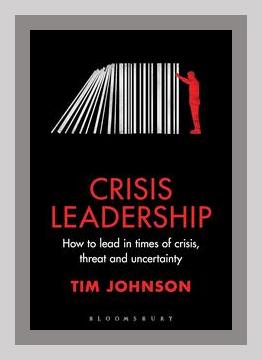Leadership and ManagementCrisis Management
Crisis Leadership: How to Lead in Times of Crisis, Threat and Uncertainty by Tim Johnson (2017) — Summary
Introduction
Crisis Leadership: How to Lead in Times of Crisis, Threat and Uncertainty by Tim Johnson serves as an essential guide for leaders looking to navigate through crises efficiently. Grounded in the principles of crisis management, the book provides practical advice, real-world examples, and actionable steps for leaders at all levels.
Chapter 1: Understanding Crisis Leadership
Key Points:
- Definition of Crisis Leadership: Crisis leadership is not just about solving immediate problems but managing long-term implications and preserving organizational integrity.
- Characteristics of Effective Crisis Leaders: Attributes such as decisiveness, empathy, clear communication, and resilience are crucial.
Actions:
- Self-Assessment: Conduct a personal audit to evaluate your preparedness for a crisis. For example, assess your decisiveness by reviewing past quick decisions you’ve made under pressure.
- Team Evaluation: Identify team members with complementary skills, such as strong communication abilities or technical expertise, to form a crisis management team.
Chapter 2: Building a Crisis-Ready Organization
Key Points:
- Anticipation and Planning: Use scenario planning to anticipate possible crises.
- Training and Simulations: Regular training sessions and crisis simulations keep the team prepared.
- Communication Strategies: Develop a robust internal and external communication plan.
Actions:
- Scenario Planning Workshop: Organize a workshop where team members brainstorm and plan for potential crises. For instance, create scenarios such as supply chain disruptions or cyber-attacks.
- Crisis Simulations: Conduct quarterly simulations to practice response strategies. Use real-world examples like mock data breaches to challenge the team.
Chapter 3: Immediate Response Protocols
Key Points:
- Initial Assessment: Quick and accurate assessment of the situation is crucial.
- Stakeholder Communication: Engage all stakeholders—employees, customers, shareholders, media—immediately with honest and clear information.
- Resource Allocation: Mobilize resources swiftly to address immediate needs.
Actions:
- Create an Assessment Checklist: Develop a checklist for immediate response to ensure no critical aspects are overlooked during an initial crisis evaluation.
- Communication Plan Templates: Prepare templates for press releases and internal communications. For example, draft a sample email to employees detailing initial actions and reassurances.
Chapter 4: Decision-Making Under Pressure
Key Points:
- Rapid Decision-Making Frameworks: Frameworks like OODA Loop (Observe, Orient, Decide, Act) can aid in making fast, informed decisions.
- Balancing Speed and Accuracy: While quick decisions are necessary, they must be informed by accurate data to minimize mistakes.
Actions:
- Implement OODA Loop: Regularly practice the OODA Loop framework in team meetings for minor decisions to build habit and speed.
- Data Reliability Checks: Establish protocols for data verification before key decisions. For instance, verify information with at least two reliable sources before acting.
Chapter 5: Communication During Crisis
Key Points:
- Transparency: Absolute transparency is critical to maintaining trust.
- Consistent Messaging: Ensure all communications are consistent across different platforms and to different audiences.
- Message Control: Designate spokespersons to control the narrative.
Actions:
- Develop a Communication Grid: A matrix that outlines what information is shared with whom and when.
- Spokesperson Training: Regularly train designated spokespersons through media training sessions, including mock interviews based on past crises examples.
Chapter 6: Managing Public Perception
Key Points:
- Media Relations: Proactively manage media relations to shape public perception.
- Social Media Monitoring: Use social media listening tools to gauge public sentiment and respond appropriately.
- Customer Engagement: Maintain open lines of communication with customers to reassure them and provide updates.
Actions:
- Media Engagement Protocols: Develop protocols for engaging with the media, including how to handle interviews and press conferences.
- Social Media Team: Assemble a dedicated social media response team to monitor and engage with online communities during a crisis.
Chapter 7: Recuperation and Learning
Key Points:
- Post-Crisis Analysis: Conduct thorough post-crisis evaluations to understand what worked and what didn’t.
- Employee Support: Provide support for employees to help them recover from the crisis.
- Policy Revisions: Update crisis management plans based on lessons learned.
Actions:
- After-Action Review (AAR): Schedule and implement an AAR meeting with all key stakeholders to dissect the crisis response.
- Employee Assistance Programs (EAP): Establish or update EAPs to include mental health support for employees affected by the crisis.
- Policy Update Meeting: Hold a dedicated session to revise and update crisis policies based on AAR outcomes.
Chapter 8: Ethical Considerations in Crisis
Key Points:
- Moral Leadership: Uphold ethical standards even in the face of pressure.
- Fairness and Equity: Ensure all actions taken during a crisis are fair and consider the implications for all stakeholders.
Actions:
- Ethical Decision-Making Framework: Create an ethical framework for decision-making that can be applied during crises.
- Stakeholder Impact Analysis: Perform analyses to understand how different decisions will impact various stakeholders, making adjustments to ensure fairness.
Chapter 9: Case Studies and Examples
Key Points:
- Real-World Examples: Examination of successful and failed crisis responses, such as Johnson & Johnson’s handling of the Tylenol poisonings.
- Learning from Failure: Analyze what went wrong in case studies to avoid similar pitfalls.
Actions:
- Case Study Reviews: Regularly review and discuss case studies within your team to keep lessons fresh in mind.
- Scenario-Based Drills: Use elements from case studies to develop and run scenario-based drills that test your team’s readiness.
Conclusion
Tim Johnson’s Crisis Leadership: How to Lead in Times of Crisis, Threat and Uncertainty encapsulates comprehensive strategies and practical steps for effective crisis management. By focusing on planning, decision-making, communication, and ethical considerations, leaders can navigate crises more effectively, preserving organizational integrity and stakeholder trust.
Overall Actions:
- Continuous Training: Make ongoing crisis management training a staple within the organization.
- Regular Policy Revisions: Commit to regularly updating crisis management policies based on new insights and evolving risks.
With actionable insights and robust examples, leaders can transform crises into opportunities for growth and improvement.
